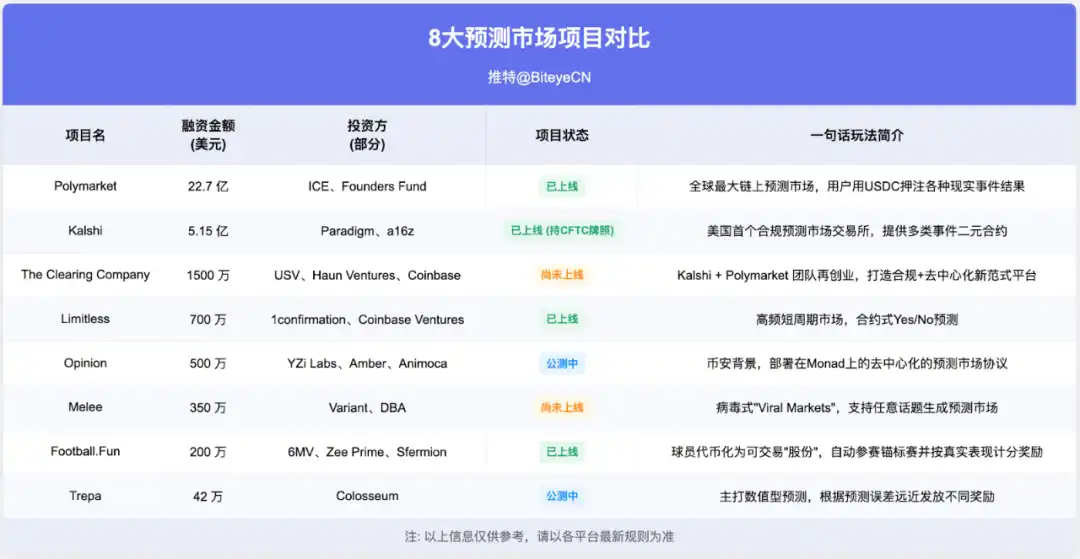Betting on the real world: What kind of business are these 8 prediction markets doing?
Which new-generation projects are attempting to break away from the old path of "speculative games"?
Original Title: "Betting on the Real World: What Kind of Business Are These 8 Prediction Markets Doing?"
Original Author: Viee, Core Contributor at Biteye
Recently, the prediction market sector has seen a surge in popularity. In early October, ICE, the parent company of the New York Stock Exchange, announced an investment of up to $2 billion in Polymarket, bringing its post-investment valuation to around $9 billion; a few days later, the US-compliant prediction market Kalshi also completed a $300 million financing round, raising its valuation to $5 billion.
With massive funding, leading platforms like Kalshi and Polymarket have seen a spike in trading volume. Kalshi is expected to reach an annualized trading volume of $50 billion this year, capturing over 60% of the global market share and surpassing Polymarket for the first time.
As the crypto narrative cools and regulatory scrutiny tightens, why are prediction markets being revisited? Has their product form truly undergone a qualitative change? Which new-generation projects are attempting to break away from the old path of "speculative games"?
The following are eight representative project samples, offering a glimpse into the different approaches in product design, compliance strategies, and financing logic within this sector.

01 Ploymarket, @Ploymarket
Polymarket is currently the world's largest prediction market platform, having secured a massive $2.279 billion in funding. In October, ICE, the parent company of the NYSE, committed to invest up to $2 billion, bringing Polymarket's pre-investment valuation to $9 billion.
Polymarket was founded in 2020 by Shayne Coplan, who participated in the Ethereum ICO while still in high school and is regarded as a "prodigy" in the crypto community. Facing regulatory pressure, Polymarket acquired the CFTC-licensed derivatives exchange QCEX for $112 million in 2025, thereby obtaining legal operating qualifications in the US.
Polymarket follows the classic prediction market model, allowing users to bet on the outcomes of real-world events using cryptocurrencies by purchasing "prediction shares," each representing a bet on a specific outcome. When the event outcome is revealed, users holding shares of the correct result receive corresponding returns. The entire trading process is conducted on-chain and settled in USDC, ensuring both fund stability and transparency.
02 Kalshi, @Kalshi
Kalshi is the first licensed and compliant comprehensive prediction market exchange in the US, having raised $515 million in funding led by Paradigm and a16z.
Kalshi was founded in 2018 at MIT by Tarek Mansour and Luana Lopes Lara. The two founders chose a difficult but compliant path, engaging in a long-term regulatory battle with the Commodity Futures Trading Commission (CFTC), and ultimately became the first prediction market platform to receive CFTC regulatory approval.
Since opening to the US market in 2021, Kalshi has offered contracts on a variety of events, including political elections, economic indicators, and sports events. In 2024, it won the right to list US presidential election contracts through litigation, filling a compliance gap.
03 The Clearing Company, @theclearingco
The Clearing Company is a prediction market launched by former teams from Kalshi and Polymarket, having raised $15 million in funding. CEO Toni Gemayel previously served as head of platform growth at both Kalshi and Polymarket.
The platform is currently in the preparation and development stage, with the team focusing on simplifying the user experience, aiming to make the new product as easy to use as Robinhood or Coinbase for ordinary users, while also emphasizing compliant product design. From the concept, this type of product seeks a compromise between regulatory requirements and lowering the user understanding threshold, but whether it can truly establish an effective market ecosystem remains to be seen.
04 Limitless, @trylimitless
Limitless is a high-frequency prediction market offering short-term price prediction contracts ranging from minutes to intraday. It has raised about $7 million in funding from well-known crypto funds such as 1confirmation and Coinbase Ventures, and was founded in 2023 by CJ Hetherington and others.
Limitless officially launched on the Base mainnet in May 2025, later expanding to Arbitrum and other Layer 2s. Its product form is closer to traditional contract exchanges, allowing users to bet "Yes/No" in short-cycle price markets, with preset expiration times and outcomes determined by on-chain oracles at settlement.
From the data, Limitless has created numerous ultra-short-term trading scenarios, with some users engaging in short-term arbitrage by leveraging quick and clear outcomes. However, this has also drawn criticism from the community: some users pointed out that the platform had previously listed markets with predetermined or nearly impossible outcomes without charging fees, such as BTC price markets within 1.5 hours. Such "open card markets" were exploited by arbitrageurs to inflate trading volume. The team has since responded by optimizing market generation rules to prevent such situations.
05 Opinion, @opinionlabsxyz
Opinion Labs (O.LAB) has currently raised $5 million in funding, led by YZi Labs, with other investors including Echo, Animoca Ventures, Manifold Trading, Amber Group, and others.
In terms of progress, Opinion has launched a prediction market on the Monad testnet to collect community feedback and has a cooperative background with Binance Labs.
06 Melee, @meleemarkets
Melee is a new prediction market backed by Variant Fund, aiming to create "Viral Markets"—allowing any topic to generate a prediction market and gain traffic through viral spread. It has completed a $3.5 million funding round, with investors including Variant and DAO Builders Alliance (DBA). Co-founder and CEO Max previously served as Head of Strategy at Ava Labs and founded a short video influencer brand, giving him unique insights into community operations and business strategy.
As of now, Melee is still in the development and pre-launch phase, with no official product release. The website currently only offers a waitlist registration, allowing users to join by linking their X account. According to official information, Melee's "viral market" concept includes three main features: any topic can become a market, a closed loop for creator monetization, and early participation incentives. It is positioned at the intersection of social and prediction markets, attempting to stimulate broad participation through a UGC (user-generated market) model.
07 Football.Fun, @footballfun
Football.Fun centers on player prediction as its core mechanism, tokenizing real-world professional players into tradable "shares." Users can hold player cards and earn points and settlement rewards based on their performance in real matches. Founder Adam is a member of the WolvesDAO community, and the project has completed a $2 million seed round with investors including 6th Man Ventures, Zee Prime, Sfermion, and others.
08 Trepa, @trepa_io
Trepa focuses on numerical predictions, allowing users to predict specific values for macroeconomic indicators and receive varying degrees of rewards based on the size of their error. It has completed about $420,000 in funding, with lead investor Colosseum, a fund founded by a former Solana Foundation growth lead.
The Trepa team was established in Singapore in 2024, with core members from diverse backgrounds. It is currently in public beta, allowing users to select a prediction topic (mostly macroeconomic or financial data, such as a country's inflation rate or quarterly GDP growth), and submit predictions by dragging a value slider or entering a specific number. Unlike traditional binary markets with only "right/wrong" outcomes, Trepa uses a continuous reward mechanism: the closer the predicted value is to the actual result, the higher the reward, and even if the guess is off, partial returns can still be earned.
09 Compliance Risks: The Greatest Uncertainty in the Sector
Looking at the eight projects above, it is clear that prediction markets have already shown significant differentiation in product design and technical implementation. However, regardless of the model, the common challenge remains how regulators define their legal attributes.
Prediction markets are inherently characterized by "speculation + gambling," making them a sensitive industry in most jurisdictions. In the US, a few projects like Kalshi have obtained compliance licenses, while Polymarket has attempted to build a legal path through acquisitions. However, most projects remain in a regulatory gray area.
Furthermore, even on-chain platforms inevitably face the following risks:
· Market manipulation: A small amount of capital can influence price direction, undermining information efficiency
· Oracle risk: Data source errors or attacks can directly lead to settlement errors
· Contract security: Some new platforms have not undergone complete audits, posing a risk of fund theft
· Exit difficulty: Some markets have limited liquidity, creating a risk of funds being trapped
Based on experience, it is generally not recommended to go ALL-IN on prediction markets; instead, a diversified, small-bet strategy is advisable to hedge against the uncertainty of individual markets. For those eager to participate, it is also recommended that beginners choose compliant and user-friendly platforms, with Polymarket being a good starting point.
In addition, the biggest barrier for newcomers is understanding the trading mechanism and technical usage. In prediction markets, placing an order is not as intuitive as simply buying up or down; you need to understand the probability represented by the odds or price. For example, a price of 0.20 means the market believes there is a 20% chance the event will occur, which requires some skill to convert from traditional odds. It is recommended to spend time reading the platform's beginner guides or online educational articles to understand binary market profit and loss calculations.
10 Final Thoughts: Tool or Speculative Variant?
Prediction markets are not a new phenomenon. As early as around 2000, many think tanks and economists regarded them as one of the tools for "information integration and social consensus formation." In reality, over the past two decades, whether in Web2 scenarios or on-chain applications, prediction markets have never achieved large-scale breakthroughs. On one hand, compliance barriers have limited their user base; on the other, their speculative nature has made it difficult to gain broad support from public institutions.
The renewed popularity of Polymarket and Kalshi may be a pursuit of new themes in the capital cycle, or simply a supplement to market gaming tools. In any case, it is far from being a force that "changes market structure."
The real turning point for this sector lies not in product form, but in institutional boundaries. Until a complete risk control and access system is established, we still need to observe calmly.
Disclaimer: The content of this article solely reflects the author's opinion and does not represent the platform in any capacity. This article is not intended to serve as a reference for making investment decisions.
You may also like
Ethereum in free fall among companies: What is happening?

Strategy stops massive BTC buying: Should we worry?

The Numbers Behind Bitcoin’s Institutional Boom

Revolutionary Decentralized Spot Exchange AlphaSec Launches on Kaia Network
